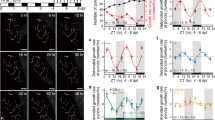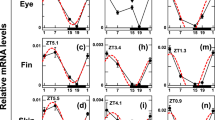Abstract
The photoneuroendocrine system translates environmental light conditions into the circadian production of endocrine and neuroendocrine signals. Central to this process is the pineal organ, which has a conserved role in the cyclical synthesis and release of melatonin to influence sleep patterns and seasonal reproduction1. In lower vertebrates, the pineal organ contains photoreceptors whose activity entrains an endogenous circadian clock and regulates transcription in pinealocytes1. In mammals, pineal function is influenced by retinal photoreceptors that project to the suprachiasmatic nucleus—the site of the endogenous circadian clock. A multisynaptic pathway then relays information about circadian rhythmicity and photoperiod to the pineal organ1. The gene cone rod homeobox (crx), a member of the orthodenticle homeobox (otx) family, is thought to regulate pineal circadian activity. In the mouse, targeted inactivation of Crx causes a reduction in pineal gene expression and attenuated entrainment to light/dark cycles2. Here we show that crx and otx5 orthologs are expressed in both the pineal organ and the asymmetrically positioned parapineal of larval zebrafish. Circadian gene expression is unaffected by a reduction in Crx expression but is inhibited specifically by depletion of Otx5. Our results indicate that Otx5 rather than Crx regulates genes that show circadian expression in the zebrafish pineal complex.
This is a preview of subscription content, access via your institution
Access options
Subscribe to this journal
Receive 12 print issues and online access
$209.00 per year
only $17.42 per issue
Buy this article
- Purchase on Springer Link
- Instant access to full article PDF
Prices may be subject to local taxes which are calculated during checkout






Similar content being viewed by others
Accession codes
References
Korf, H.W., Schomerus, C. & Stehle, J.H. The pineal organ, its hormone melatonin, and the photoneuroendocrine system. Adv. Anat. Embryol. Cell. Biol. 146, 1–100 (1998).
Furukawa, T., Morrow, E.M., Li, T., Davis, F.C. & Cepko, C.L. Retinopathy and attenuated circadian entrainment in Crx-deficient mice. Nature Genet. 23, 466–470 (1999).
Masai, I. et al. floating head and masterblind regulate neuronal patterning in the roof of the forebrain. Neuron 18, 43–57 (1997).
Gothilf, Y. et al. Zebrafish serotonin N-acetyltransferase-2: marker for development of pineal photoreceptors and circadian clock function. Endocrinology 140, 4895–4903 (1999).
Stenkamp, D.L., Cunningham, L.L., Raymond, P.A. & Gonzalez-Fernandez, F. Novel expression pattern of interphotoreceptor retinoid-binding protein (IRBP) in the adult and developing zebrafish retina and RPE. Mol. Vis. 4, 26 (1998).
Whitmore, D., Foulkes, N.S., Strahle, U. & Sassone-Corsi, P. Zebrafish Clock rhythmic expression reveals independent peripheral circadian oscillators. Nature Neurosci. 1, 701–707 (1998).
Delaunay, F., Thisse, C., Marchand, O., Laudet, V. & Thisse, B. An inherited functional circadian clock in zebrafish embryos. Science 289, 297–300 (2000).
Cermakian, N., Whitmore, D., Foulkes, N.S. & Sassone-Corsi, P. Asynchronous oscillations of two zebrafish CLOCK partners reveal differential clock control and function. Proc. Natl Acad. Sci. USA 97, 4339–4344 (2000).
Cahill, G.M. Circadian regulation of melatonin production in cultured zebrafish pineal and retina. Brain Res. 708, 177–181 (1996).
Whitmore, D., Foulkes, N.S. & Sassone-Corsi, P. Light acts directly on organs and cells in culture to set the vertebrate circadian clock. Nature 404, 87–91 (2000).
Vignali, R. et al. Xotx5b, a new member of the Otx gene family, may be involved in anterior and eye development in Xenopus laevis. Mech. Dev. 96, 3–13 (2000).
Kuroda, H., Hayata, T., Eisaki, A. & Asashima, M. Cloning a novel developmental regulating gene, Xotx5 : its potential role in anterior formation in Xenopus laevis. Dev. Growth Differ. 42, 87–93 (2000).
Mori, H., Miyazaki, Y., Morita, T., Nitta, H. & Mishina, M. Different spatio-temporal expressions of three otx homeoprotein transcripts during zebrafish embryogenesis. Brain Res. Mol. Brain Res. 27, 221–231 (1994).
Liu, Y., Shen, Y., Rest, J.S., Raymond, P.A. & Zack, D.J. Isolation and characterization of a zebrafish homologue of the cone rod homeobox gene. Invest. Ophthalmol. Vis. Sci. 42, 481–487 (2001).
Furukawa, T., Morrow, E.M. & Cepko, C.L. Crx, a novel otx-like homeobox gene, shows photoreceptor-specific expression and regulates photoreceptor differentiation. Cell 91, 531–541 (1997).
Borg, B., Ekstrom, P. & van Veen, T. The parapineal organ of teleosts. Acta Zoologica 64, 211–218 (1983).
Concha, M.L., Burdine, R.D., Russell, C., Schier, A.F. & Wilson, S.W. A nodal signaling pathway regulates the laterality of neuroanatomical asymmetries in the zebrafish forebrain. Neuron 28, 399–409 (2000).
Bisgrove, B.W., Essner, J.J. & Yost, H.J. Multiple pathways in the midline regulate concordant brain, heart and gut left–right asymmetry. Development 127, 3567–3579 (2000).
Liang, J.O. et al. Asymmetric nodal signaling in the zebrafish diencephalon positions the pineal organ. Development 127, 5101–5112 (2000).
Nasevicius, A. & Ekker, S.C. Effective targeted gene 'knockdown' in zebrafish. Nature Genet. 26, 216–220 (2000).
Chuang, J.C., Mathers, P.H. & Raymond, P.A. Expression of three Rx homeobox genes in embryonic and adult zebrafish. Mech. Dev. 84, 195–198 (1999).
Bobola, N. et al. OTX2 homeodomain protein binds a DNA element necessary for interphotoreceptor retinoid binding protein gene expression. Mech. Dev. 82, 165–169 (1999).
Li, X. et al. A pineal regulatory element (PIRE) mediates transactivation by the pineal/retina-specific transcription factor CRX. Proc. Natl Acad. Sci. USA 95, 1876–1881 (1998).
Chen, S. et al. Crx, a novel Otx-like paired-homeodomain protein, binds to and transactivates photoreceptor cell-specific genes. Neuron 19, 1017–1030 (1997).
Adelmant, G., Begue, A., Stehelin, D. & Laudet, V. A functional Rev-erb α responsive element located in the human Rev-erb α promoter mediates a repressing activity. Proc. Natl Acad. Sci. USA 93, 3553–3558 (1996).
Sakamoto, K. et al. Molecular cloning of the cone-rod homeobox gene ( Crx ) from the rat and its temporal expression pattern in the retina under a daily light-dark cycle. Neurosci. Lett. 261, 101–104 (1999).
Foulkes, N.S., Borjigin, J., Snyder, S.H. & Sassone-Corsi, P. Transcriptional control of circadian hormone synthesis via the CREM feedback loop. Proc. Natl Acad. Sci. USA 93, 14140–14145 (1996).
Guillaumond, F. et al. Circadian binding activity of AP-1, a regulator of the arylalkylamine N- acetyltransferase gene in the rat pineal gland, depends on circadian Fra-2, c-Jun, and Jun-D expression and is regulated by the clock's zeitgebers. J. Neurochem. 75, 1398–1407 (2000).
Hukriede, N.A. et al. Radiation hybrid mapping of the zebrafish genome. Proc. Natl Acad. Sci. USA 96, 9745–9750 (1999).
Zhang, J., Talbot, W.S. & Schier, A.F. Positional cloning identifies zebrafish one-eyed pinhead as a permissive EGF-related ligand required during gastrulation. Cell 92, 241–251 (1998).
Acknowledgements
We thank M. Macurak, J. Prowell and L. Hantsoo for technical help. This work was supported by an American Cancer Society postdoctoral fellowship (J.T.G.), the Institut National de la Santé et de la Recherche Médicale, Centre National de la Recherche Scientifique, Hôpital Universitaire de Strasbourg, Association pour la Recherche sur le Cancer, Ligue Nationale Contre le Cancer (C.T., B.T.), NIH grants (C.T., B.T., P.A.R.) and an NRSA fellowship (J.O.L.).
Author information
Authors and Affiliations
Corresponding author
Rights and permissions
About this article
Cite this article
Gamse, J., Shen, YC., Thisse, C. et al. Otx5 regulates genes that show circadian expression in the zebrafish pineal complex. Nat Genet 30, 117–121 (2002). https://doi.org/10.1038/ng793
Received:
Accepted:
Published:
Issue Date:
DOI: https://doi.org/10.1038/ng793
This article is cited by
-
Brain-specific homeobox Bsx specifies identity of pineal gland between serially homologous photoreceptive organs in zebrafish
Communications Biology (2019)
-
Eye Degeneration and Loss of otx5b Expression in the Cavefish Sinocyclocheilus tileihornes
Journal of Molecular Evolution (2019)
-
Clock genes expression and locomotor activity are altered along the light–dark cycle in transgenic zebrafish overexpressing growth hormone
Transgenic Research (2017)
-
Dbx1b defines the dorsal habenular progenitor domain in the zebrafish epithalamus
Neural Development (2014)
-
Pax6 regulates the formation of the habenular nuclei by controlling the temporospatial expression of Shhin the diencephalon in vertebrates
BMC Biology (2014)



